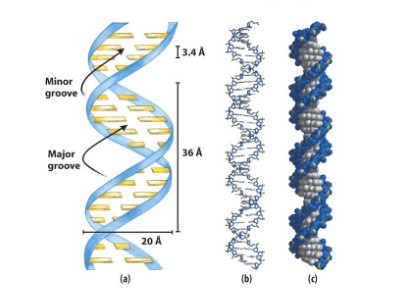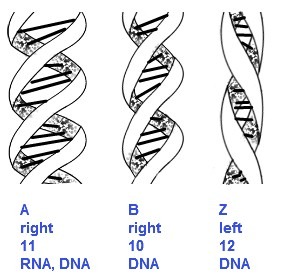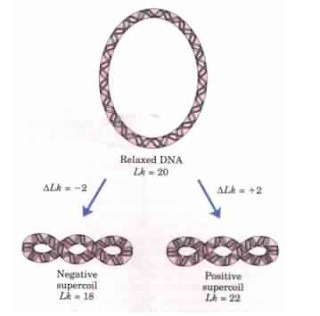Deoxyribonucleic acid (DNA)
Deoxyribonucleic acid (DNA) is a powerful polymer of deoxyribonucleotides joined together with the help of phosphodiester bonds. It contains the bases such as: Adenine, Guanine, Cytosine, and Thymine. DNA molecules are very large and are usually composed of two polynucleotide chains coiled together to form a double helix 2.0 nm in diameter.
The monomers of DNA are called deoxyribonucleotides because the sugar found in them is deoxyribose.

The bond that links the monomers together to make the polymer is known as phosphodiester bond because it consists of a phosphate that forms a bridge between the 3 ‘-hydroxyl of one sugar and and therefore the 5 -hydroxyl of an adjacent sugar.
Purine and pyrimidine bases are attaches to the 1′ carbon of the deoxyribose sugars, and the bases extend towards the center of the cylinder formed by the two chains. (The numbers designating the carbons in the sugars are given a prime to distinguish them from the numbers designating the carbons and nitrogens in the nitrogenous bases).

The bases from each strand interact with those of the other strand, forming base pairs. The base pairs are stacked on the very top of the center, one base pair every 0.34 nm.
The purine adenine (A) of one strand is always paired with the pyrimidine thymine (T) of the opposite strand by two hydrogen bonds. T
The purine guanine (G) pairs with cytosine (C) with three hydrogen bonds. This AT and GC base pairing means, the two strands in a DNA helix are complementary.

The two polynucleotide strands of DNA fit together much like the pieces in a jigsaw puzzle.
Therefore when the strands twisted by one another, a wide major groove and narrower minor groove are created by the backbone. There are 10.5 base pairs per turn of the helix, and each turn of the helix has a vertical length of 3.4 A.
The helix is right-handed; that is, the chains turn counter clockwise as they approach a viewer looking down the longitudinal axis. The two backbones are anti-parallel, which means they run in opposite directions with respect to the orientation of their sugars.
One end of every strand has been exposed to 5′-hydroxyl group, frequently with phosphates attached, although the other end has a free 3 ‘-hydroxyl group.

The structure of DNA just described is that of the B form, the most common form in cells. Two other forms of DNA have been identified. The A form primarily differs from the B form in that it has 11 base pairs per helical turn, rather than 10.5, and a vertical length of 2.6 A, rather than 3.4.
Thus it is wider than the B form. The Z form is dramatically different, having a left-handed helical structure, rather than right-handed as seen in the B and A forms. The Z form has 12 base pairs per helical turn and a vertical rise of 3.7 A.
Thus it is more slender than the B form. At this time, it is unclear whether the A form is found in cells. However, evidence exists that small portions of chromosomes can be in the Z form. The role, if any, for these stretches of Z DNA is unknown.

There is another property of DNA that needs to be addressed: supercoiling. DNA is helical; that is, it is a coil. Whenever the rotation of a coil is restrained in some way, it causes the coil to coil on itself. The coiling of a coil is supercoiling.
Recall that most bacterial chromosomes are closed, circular double-stranded DNA molecules. In this state, the two strands are unable to rotate freely relative to each other, and the molecule is said to be strained. The strain is relieved by supercoiling.

There are two types of supercoiling: positive and negative. For DNA, these are defined by the change in number of base pairs per turn in the double helix. As just discussed, the B form of DNA has 10.5 base pairs per turn of the helix.
Supercoiling that lowers the count of base pairs per turn is said to be negative supercoiling. Likewise, supercoiling that boost the number of base pairs per turn is called positive supercoiling. Bacterial chromosomes are generally negatively supercoiled.
What is the importance of supercoiling?
- Supercoiling helps compact DNA in order that it fits into the cell.
- Supercoiling also “loosens” up the DNA, making it easier to separate the two strands from each other.
- Separation of the two strands is an important early step in both DNA replication and transcription.
Deoxyribonucleic acid (DNA)
Reference and Sources
- 1% – https://www.toppr.com/content/story/amp/double-helical-structure-of-dna-18416/
- 1% – https://fliphtml5.com/ttzy/vzzw/basic/201-250
- 1% – https://quizlet.com/194311909/microbiology-13-slides-flash-cards/
- 1% – http://www.chemguide.co.uk/organicprops/aminoacids/dna1.html
- 2% – https://www.slideshare.net/raiuniversity/bsc-agri-i-pog-unit-1-introduction-to-genetics
- 1% – https://quizlet.com/120049904/biology9-ch-92-the-structure-of-dna-flash-cards/
- 1% – https://www.slideshare.net/vanithavani15/the-structures-of-dna-rna
- 1% – https://en.wikipedia.org/wiki/RNA_structure
- 1% – https://academic.oup.com/nar/article-abstract/33/7/2210/2401289
- 1% – https://www.ncbi.nlm.nih.gov/pmc/articles/PMC4482702/
- 1% – https://silo.pub/nucleic-acids-in-chemistry-and-biology.html
- 1% – https://quizlet.com/97888922/mcb-exam-2-saplingdiscussion-questions-flash-cards/
- 1% – https://mafiadoc.com/schaums-outline-seriespdfyimgcom_59cf4a591723dd8df1150d91.html
- 1% – https://quizlet.com/337866860/micro-exam-2-flash-cards/
